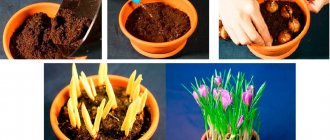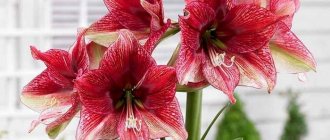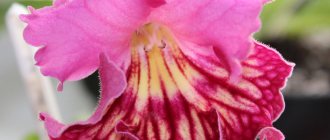Author of the article
Daria Vorontsova
Reading time: 10 minutes
AA
In early spring, crocuses blooming on the windowsill are the perfect decoration for a room, symbolizing the arrival of warmth and spring.
These delicate primroses can safely be called unique, because it is from the petals of some varieties of crocuses that the most valuable and expensive spice in the world - saffron - is made.
Growing crocuses at home is quite simple; these perennial flowers are relatively unpretentious and do not require a lot of money and effort. With the right approach, growing saffron on a windowsill will bring real pleasure and help decorate your home with delicate flowers.
Varieties of spring-blooming crocuses
There are about 300 different types and subspecies of saffron, intended for cultivation at home or for growing in open ground.
Spring crocus
A typical representative of the Shafranov family. It is distinguished by purple petals, a bell-shaped corolla, and orange stamens. The leaf blades are colored dark green. Flowering begins in early spring and lasts 14 days.
Crocus biflora
In nature, the plant is found in the Crimea, the Caucasus, Iran, and some areas of Italy. The flower has an unusual color.
The main color of the petals is creamy white, but they have oblong burgundy-purple spots and longitudinal lines. Stamens yellow, elongated.
Golden crocus
A short, squat plant, the height does not exceed 20 cm. The homeland of the golden crocus is the Balkan Peninsula and some Asian countries. The flowers are bright yellow, the leaf blades are rich green.
There are two most famous subspecies of golden crocus - Blue Bonnet, Nanette. Flowering begins in April and lasts 10 days.
Crocus Tomasini
The species is found on hillsides and in deciduous forests. Crocus was first discovered in Hungary, the Czech Republic, Montenegro, and Serbia.
Tomasini corollas are of a delicate lilac hue; the peculiarity of the variety is the ability to form 3 flowers from one bulb. The most common subspecies are Lylek Beauty and Whitewell Purple.
Dutch hybrids
This variety is artificially bred for cultivation at home. The varieties Vesenny and Uzkolistny are taken as the basis. Dutch hybrids are distinguished by their large flower size; Flowering duration is 20 days.
What problems might there be and how to solve them?
At home, crocuses rarely get sick, and most of the problems arise from fungal diseases and diseases of the bulbs.
- You should not buy deformed bulbs with wounds . If the bulbs are from your own plants, you can try to save them: sprinkle the wound with wood ash and leave to dry for several hours. Otherwise, the diseased crocus will grow with flattened leaves, and its buds will never open.
- Penicillium (gray) rot occurs due to an excessively warm and damp climate. The affected leaves should be removed and the plant should be watered with a fungicide solution. And, naturally, adjust the temperature in the room and reduce spraying.
- Fusarium is a fungal disease that appears as orange-pink stripes on the leaves. Fungal spores are carried by the wind and can affect plants that are placed in pots on an open window in the summer. A fungicide will also help control the fungus.
Features of forcing
Forcing crocuses is a special procedure. In a short period of time you can grow a large flower with a long flowering period.
Selection of planting material
A high-quality bulb must meet the following requirements:
- Dense structure, uniform dark brown color of the husk.
- Absence of any mechanical damage on the surface of the nodule.
- Healthy scales without rot, mold, or unpleasant odor.
- The diameter of a good bulb is at least 7 cm. It is believed that a large tuber is the key to large flowers.
Important! The bulb should be in a state of complete rest. The presence of sprouts and roots will not allow the flower to germinate by the desired date.
Cooling
Planting crocuses in the ground - 70–80 days before the desired flowering
It is important to refrigerate the bulbs until this time. Often a regular refrigerator is used for this.
Saffron tubers are placed in a paper bag, placed in a cellar, refrigerator with a temperature within +3...8 ° C for a period of 25 to 30 days.
Rooting, flowering
It is better to plant crocuses in flat, wide containers; the flower takes root in them faster
How to plant crocuses in a pot at home? It is important to adhere to the following algorithm of actions:
- Place drainage at the bottom of the bowl. It can be expanded clay, broken brick, polystyrene foam. Without drainage, water will stagnate, causing the bulb to rot.
- Add a small amount of soil.
- Place the planting material in the center.
- Cover with soil so that a very thin layer of soil remains above the tail.
Advice! If the goal is to grow only flowers, without subsequent propagation of the bulb, then sand can be used instead of soil.
The pot of crocuses should be kept in a cool, dark place until germination.
Sprouted saffrons should be kept at a temperature no higher than +20 °C, otherwise flowering will occur faster than expected and will be short-lived. Water once every 20 days.
If flowering is planned for March, then the planting material is cooled in November, and the bulbs are planted in the ground in December.
Preparing for planting - choosing container and soil
To grow indoors, crocuses are planted in groups in wide, low containers.
Such mini-clearings look more attractive than single plants. Expanded clay or pebbles must be poured into the bottom of the ceramic bowl as drainage. The soil is mixed from humus and coarse sand or agroperlite. It is recommended to add some bone meal. Corms can be planted in a “sand jacket”. Expanded clay should be poured onto the bottom of the pot, then 2-3 cm of nutritious soil mixture. The bulbs need to be placed in a container, with only the bottom buried in the ground. Then fill it completely with sand. With this growing method, the roots receive nutrients, and the corms do not suffer from excess moisture and rotting.
Growing crocuses in a pot
Crocuses are grown at home using the forcing method.
When the sprouts are strong enough and have reached a height of 3-5 cm, the pot should be taken out into the light and the temperature should be maintained at 10-15 degrees. In favorable conditions, saffron will bloom in two weeks.
Did you know? Forcing is the process of bringing a bulbous plant out of dormancy to flower at an unusual time, performed under the influence of physical factors - temperature, humidity, lighting.
Watering crocuses
Crocus does not like excess moisture and is resistant to drought, so you need to water the plant moderately, 2-3 times a week when the top layer of soil dries out. During flowering, the plant should be watered through a tray, removing excess liquid half an hour after watering.
Fertilizer and feeding
The plant does not need to be fertilized during planting. Potassium and phosphorus fertilizers are most useful for the development and flowering of crocuses. Fertilizing is done at the emergence of seedlings (in a 2:1 ratio), during the formation of buds and after flowering (in equal parts). The use of nitrogen fertilizers is not recommended.
Care for long-term flowering
To find out why the crocuses stopped blooming, you need to analyze the conditions under which they were kept. Do not forget that saffron is a spring primrose, and it may not like the temperature (20 degrees or above) or too bright room lighting. To prolong the flowering of your home crocus, you need to hide it from direct sunlight or bright lamp light and maintain a cool temperature (14–16 degrees, at night even below 0). In the right conditions, the decorative effect of some varieties lasts up to three weeks.
Did you know? One of the most expensive spices in the world, saffron
, is made from the dried stigmas of saffron sativum flowers. To get a kilogram of spice, you need to collect the stigmas of 200 thousand flowers. The lead in world spice production (90%) belongs to Iran.
Caring for Crocus when forcing at home
In order to grow flowers correctly, you need to choose only high-quality, clean bulbs without stains or any damage.
Crocuses can be planted for forcing in an apartment even in winter.
- In order to plant bulbs in a pot, you need to select them by size so that they are all the same. They are dug up in September, thoroughly cleared of soil and kept at a temperature of 22 degrees for two weeks. After this, each onion is wrapped in a napkin and put away for storage.
- Before planting the bulbs, they must be kept at a temperature of 9 degrees, and then planted in low pots. In this case, the bulbs should not touch the pot; they should be at some distance from each other.
- After this, they are placed in the refrigerator for two months at a temperature of 5-9 degrees. All this time they take root.
- When the sprouts reach 4 cm in size, they must be brought into a room where the temperature is 16 degrees. You should provide your plants with good lighting.
- In about three weeks the plants will bloom. After the plant has finished blooming, it will need to be watered moderately until the leaves fall off. Then the bulbs are dug up and sent back to storage.
General information about culture
Saffron, or crocus, is a member of the Iris family. Belongs to the genus of perennial corms. It reaches a height of up to 15 cm.
The size of the bulb can be up to 3 cm in diameter. One, rarely 2-3, flowers grow from it. They are divided into two groups based on color:
- yellow-flowered - from yellow to orange;
- blue-flowered - from light lilac to dark purple.
Activities for caring for crocuses in the open ground
Saffron leaves are linear and basal, covered with scales below. Present during and after flowering.
The seeds of the plant are angular in shape and small in size, the fruit is a three-lobed capsule.
Origin story
In the East, crocuses began to be grown before our era. They were mentioned in the writings of Hippocrates, Solomon and Homer. Introduced to Europe during the Crusades. They first began to be cultivated in the countries of the Western Mediterranean.
For your information! The first decorative species appeared in botanical gardens in Europe in the 16th century. Spring, narrow-leaved and yellow crocuses marked the beginning of the development of a large number of varieties.
Dutch hybrids took the leading position in terms of commercial success. The formation lasted several centuries. The countdown for modern commercial varieties dates back to the beginning of the twentieth century.
Saffron is used in cosmetology. It is included in balms, creams and gels. You can prepare your own care products at home. The plant nourishes, rejuvenates and improves the structure of the skin.
Medicinal properties of crocus:
- calms the nervous system;
- helps get rid of headaches;
- the best remedy for worms;
- improves brain activity;
- prevents cancer cells from spreading;
- is a strong antioxidant;
- improves liver function;
- effective for urolithiasis;
- has a positive effect on male sexual function.
Note! Dried stigmas of saffron were used as a spice before our era and to this day. To give a special taste, color and aroma it is added to pilaf, fish and meat dishes.
Appearance and flowering period
Crocus has been grown for many hundreds of years; it has become widespread in natural conditions in the Mediterranean countries, in Eastern Europe, and is also found in Central Asia. It is known that this flower was highly valued by the Egyptian pharaohs.
Crocus is a perennial bulbous plant; it is part of the botanical family Irisaceae, which has several dozen genera.
In total, there are more than 100 species of crocus, and some of them bloom not in spring, but in autumn. If you plant two types of crocuses in a room, they will be the first to welcome spring and become the last symbol of the passing summer. They are grown both in gardens and at home.
Features of Crocus:
- The height of the crocus stem can reach 25 cm; there are several scales at the root, which make the plant somewhat similar to a tulip during the flowering period. The flower is goblet-shaped, it has six petals, which can have a wide variety of colors.
- Any variety of crocus has yellow or orange stamens; this is one of the distinctive features of the plant.
- Flowers can be either one-color or two-color: white-blue, bluish-lilac, etc.
- The flowering of crocuses can be a real holiday: bright buds decorate any room, and you can predict the flowering period by a certain date: for example, you can ensure that the bud is fully bloomed by March 8 or by Christmas.
Ideal time to harvest bulbs
Having had enough of the flowering, gardeners begin to wonder: the crocuses have faded, what should we do with them next? It should be noted that these are frost-resistant plants, so they are usually not dug up and replanted for 3-5 years. During this period, the mother bulb is overgrown with up to 10 daughter bulbs.
But it is important not to miss the moment when it is simply necessary to transplant crocuses to a new place
Attention! Crocuses growing in one place for a long period can degenerate: the tubers become sick, rot, the flowers become sparse and small. There are cases described when it is recommended to dig up crocuses once a year:
There are cases described when it is recommended to dig up crocuses once a year:
- in regions with cold winters to protect against freezing;
- to prevent the spread of diseases;
- in order to obtain young planting material.
Weather for cleaning
The dormant period for autumn plants is June-August, for spring plants - July-September. It begins when the leaves of the flower fall to the ground, turn yellow and begin to peel off easily.
This is the best time to dig up crocuses after flowering for replanting, propagation and storing tubers for storage.
A dry, cool day is suitable for this type of work.
The process of digging up crocuses
Prepare inventory:
- pitchfork;
- a piece of polyethylene or tarpaulin;
- pruner;
- plastic box;
- household gloves.
Then proceed like this:
To the side of the crocus bushes, a prepared piece of film is spread on the ground. At a distance of 5-7 cm from the bush, drive the pitchfork to the full possible depth and remove the earthen lump onto the film. They carefully break it apart and take out all the tubers. They are cleared of soil manually or using a water jet
The roots are carefully cut with pruning shears. The bulbs are placed in a box, transferred to a shady place and dried, laid out on a flat surface in one layer. The problem of how to dig up planting material to replant crocuses has been solved
The problem of how to dig up planting material to replant crocuses has been solved.
Digging up crocuses
Use in home and garden
Crocuses can have many functions in the garden, but look best in a form that mimics natural clumps. A spring lawn intertwined with colorful flowers looks fantastic, although the inconvenience of this solution is the restrictions on mowing the grass.
Crocuses planted in clusters under trees and on the edges of flower beds will become a wonderful colorful accent in early spring, when the garden is still quite gray and gloomy.
It is better to plant crocuses like tulips - in large beds or in rows, creating flower chains that will look great in the garden.
It is popular to plant crocuses in rock gardens and on slopes covered with sedum or climbing plants. They are not at all bothered by the company of other plants, so they can be used for spring compositions with early spring flowers:
- snowdrops,
- hyacinths,
- daffodils.
Experienced gardeners hide crocus tubers in the lower parts of the beds, between the plants, which later come to life and can cover gradually yellowed leaves.
Crocuses are not intended for cut flowers due to their delicacy and small size, but planted in pots they will decorate an apartment, terrace or garden plot.
What conditions does the plant need?
Crocuses cannot be called whimsical plants, the main thing is that the following conditions are met:
- Low temperature - up to 20 degrees, in winter even up to 10.
- Sufficient lighting.
- You need to water a little, but regularly.
- Soil drainage.
After forcing, the plants should be left until the leaves are completely dry, but watering cannot be stopped. The bulbs are then left for storage.
Soil composition and pot volume and drainage
To choose the right pot, first determine how many bulbs you want to plant. Usually this is 5-10 pieces. The main thing is not to allow the bulbs to touch each other or the walls, so choose a low and wide pot. You can buy pots at a flower shop designed for forcing bulbs.
The soil requirements for crocuses are neutrality, lightness and drainage. You can take a flower substrate or prepare a mixture yourself from the following components, taken in equal parts:
- coarse sand;
- turf mixture;
- leaf mixture.
Another option is a thick layer of sand at the bottom, then soil, but this is only used if you later plan to use the crocus for propagation. Gravel, pieces of bricks, and tiles are sometimes also used for drainage. The pot itself must be placed on a tray where the water will flow out.
Choosing a place
On the one hand, these plants love light, so the south side of the house is best suited for them. But the temperature regime is also important. The ideal place is on the balcony. There, during the spring months, the necessary coolness is maintained, and by the time of flowering, in March-April, the air warms up to 16-20 degrees.
Lighting
Lighting depends on what stage of growth the plant is at. If you have just planted crocuses, then you need to keep them in a dark place until the sprout grows to 5 centimeters and becomes strong. Then you need to move the plants to a well-lit place where they will be exposed to sunlight for at least 4 hours a day. Move them into the shade again during flowering to keep the flowers open longer.
Temperature
Crocuses that are about to bloom or have already bloomed should be kept in the coolest place in the house. The ideal temperature is +14-16 degrees. At +20 and above, plants bloom for a very short time, and after a few hours they can shed their petals. At night, even frosts down to -3 are acceptable.
Humidity
Crocuses are drought-resistant, so they do not require abundant watering. But drainage is very important, otherwise the bulbs will rot. Under no circumstances should water stagnate in the ground. It is permissible to spray plants, but also infrequently and little by little.
State of rest
The crocus goes into a dormant state after all the leaves dry out. This period falls in the summer months
It is important to store the bulbs correctly; to do this, place them in a cool, dark and dry place. No watering is required at this time to prevent the bulbs from rotting.
Homemade crocus flowers - planting
The bulbs should be planted in a dense group, completely immersed in the ground. At the same time, a distance of 2-3 cm should remain between them and the walls of the pot. After planting, the soil needs to be compacted, watered and the dishes with the onions should be placed in a cool, dark place for rooting. The ambient temperature should not exceed 10 °C. The easiest way to create suitable conditions is in the basement or garage.
Rooting will take 2-2.5 months. During this period, the plants need to be watered only after the earthen clod has completely dried out. When the bulbs produce sprouts 4-5 cm long, and the roots are visible through the drainage hole of the pot, the plants can be moved to a bright, warm room. Flowering usually begins 10-15 days after this.
Wintering crocuses
In growing crocuses, their proper wintering is of great importance, since at this time the corms take root and form a bud.
Crocus is a fairly frost-resistant flower, so the place where the bulbs are planted does not even need to be covered. But it is better to protect it with spruce branches or branches, since the plant may not survive very severe frosts. In addition, crocus corms are a delicacy for rodents, and even crows can rake them out of the ground during snowless winters.
In the spring, the area must be cleared of branches and debris, but the soil cannot be loosened until the first shoots appear.
If the soil allows water to pass through well, then you don’t need to loosen it at all, but if this is still necessary, do it very carefully, trying not to damage the bulbs
What to do after purchasing a plant?
Crocuses reproduce by bulbs . Good living bulbs are very dense and weighty, with an intact shell and no soft areas (no signs of rotting). Once purchased, they can be stored in a moderately cool, dry place, wrapped, such as in a paper towel, and planted three months before the desired flowering period.
You can also transport crocus bulbs in a paper napkin, in a package or in a pot, sprinkled with dry soil. If after purchasing the plant you plan to plant it immediately, select a pot with a diameter of 25-30 cm , add drainage to the bottom, loamy soil on top, then the bulb (head up) and another 3-5 cm of soil on top. After planting, the crocuses are watered with warm water.
Suitable varieties for home
Dutch varieties are recommended as potted plants. These include the following:
- Prins Claus produces a pleasant and long-lasting aroma; when the appropriate conditions are created, it can bloom in winter;
- Jeanne D'Arc resembles snowdrops, only with larger flowers, the core of the buds is golden;
- Flower Record with a small stem, but voluminous inflorescences of a rich purple color;
- Blue Pearl means blue pearl; variety with azure buds, yellow at the base.
As a rule, flower growers do not stop at just one option; they create entire kaleidoscopes of different crocuses on their windowsills. The only condition is not to plant dissimilar varieties together in one container, otherwise you may end up with sprouts of different sizes and non-simultaneous flowering. The following varieties are also suitable as indoor flowers:
- Cream Beauty (delicate creamy shade);
- Golden Yellow (hybrid);
- Remembrance (rich lilac color);
- Crocus Oxonian (with dark blue buds and golden-orange core).
Possible problems during cultivation
It is necessary to choose the right planting time. For autumn-blooming crocuses this is summer , and for spring-blooming crocuses it is September. For forcing in a pot, those specimens that bloom in spring are ideal.
Advice! It is not recommended to plant crocuses of different varieties in the same container. They do not have the same bud period and flower size. The flowerpot will not look aesthetically pleasing.
With poor feeding and poor drainage, chlorosis develops. The leaves are turning yellow. It is better to moderate watering.
Features of planting bulbs for balconies
When growing any bulbous plants on a balcony or loggia, follow the general rules for planting bulbous plants in containers. It is best to study agricultural techniques for each type of plant individually, but there are still general planting principles.
- Bulb crops are always planted at a depth equal to three times the height of the bulb itself (measured from the bottom).
- It is not worth planting the bulbs too densely, since the plant is not driven out for more spectacular flowering, but is preserved and grown from year to year, and for normal growth and development it is necessary to provide a sufficient amount of free soil. The planting distance is selected in accordance with the preferences and size of a particular species. So, for crocuses the optimal distance is 5-6 cm, and for tulips - 10-12 cm.
- The substrate needs to be given more attention. For bulbous pots, light, loose, water-, breathable and necessarily nutritious soil is selected. If you make it yourself, then mix equal parts of sand, peat, turf and leaf soil. It is not advisable to use vegetable or garden soil, but if you want to save money or have no choice, be sure to improve it by adding organic fertilizers, sand and peat.
- A layer of drainage must be laid at the bottom of any container or container in which bulbs are planted. For bulbous plants, its minimum height is 5-6 cm.
- After planting, provide stable light moisture for rooting.
It is not necessary to plant only one bulbous plant in a container - they can be planted in groups or mixed together to create bulbous compositions. At the same time, the main principle of planting bulbous plants in pots is observed - arrangement in tiers. Planting is carried out from large plants to small ones, taking into account that such plants are planted at different depths and at different distances between the bulbs.
Tulips and daffodils are placed first, sprinkled with soil and the next tier of plants are placed - hyacinths or muscari, and then even smaller primrose bulbs. But when planting different bulbs together, try not to forget about an individual approach and do not thicken the plantings too much, leaving enough space for normal root development and access to nutrients.
Layout of flower bulbs in a container
Diseases and pests
If you notice that the petals on your plant are deformed and do not open, and light spots have appeared on the buds, then it is probably Crocus
affected by a viral infection.
In this case, the plant should be immediately destroyed, and the soil in which it was located should be treated with potassium permanganate.
Crocus bulbs
may be affected by fungus. In this case, they become soft, and spotted formations begin to appear under their scales.
Before planting, to prevent fungal diseases, the bulbs must be thoroughly dried and treated with special means.
Means and methods
Crocus or saffron is a delicious spring primrose grown in certain climates, often on an industrial scale, to produce a special seasoning with an unusual taste.
Greek and Iranian saffron, which has a unique and refined aroma, is especially valued.
Like any bulbous plant with beautiful flowers (such as tulips or hyacinths), bulbs can be germinated and forced to bloom by providing them with the appropriate conditions.
It is inexpressibly pleasant to receive a living plant in a pot for the holiday, which will not wither immediately in the vase, but will delight both the eyes and the heart with its flower for some time.
Many women who are not involved in dacha work or gardening, after flowering has finished, try to preserve the plant or extend its life with the help of familiar actions:
- still watering it generously;
- holding on a windowsill illuminated by the sun;
- fertilizing it in a pot with liquid fertilizers or growth stimulants;
- replanting into a larger container.
When this does not bring the expected result, they begin to look for an answer to the question of how to store crocuses at home after flowering, or how to make them bloom again. The secrets of forcing have been known for a long time.
In pre-revolutionary Russia, hyacinths were planted in pots in the form of bulbs, and placed without watering in a cool, dark and dry place. In the pre-Easter efforts, they did not forget to take the pot out of its shelter, place it closer to the light and begin moderate watering.
As a result, on the Easter table, in any weather, there was a blooming hyacinth, beautifully decorated with a corolla made of colored tissue paper. But it doesn’t make sense to place a flower pot in this way, which just recently had a holiday gift on it.
Such a bulb will not bloom a second time because it has already undergone the forcing process. Experienced gardeners recommend cutting off the drying or yellowed upper above-ground part, and digging up the bulb itself and storing it in the refrigerator, wrapped in cellophane. During the season, it can be planted in the country house, in the front garden or in the park.
How to grow a plant from seeds
This method of propagating Crocuses
is used extremely rarely, since plants planted in this way begin to bloom only five years after they are planted in the soil.
To grow crocuses
Thus, it is necessary:
*Sow seeds in spring at the end of March or late autumn. The seeds are first soaked in a growth stimulator for forty minutes, after which they are placed in a weak solution of potassium permanganate.
*Before sowing, seeds should be stratified. Pour wet sand into a not very deep container and sow seeds in it. There is no need to bury them in the ground; simply distribute them on the surface. Cover the top with film and place in the refrigerator in the vegetable compartment. The container should be kept there for three weeks.
*When the time comes, remove the container from the refrigerator and place it in a bright and warm place.
*After the seedlings appear, they need to be watered. For watering, it is recommended to use a fine spray.
*When the plants grow a little, they are planted in separate containers or directly in the flowerbed.
Features of forcing
To grow a plant and achieve abundant flowering at a certain time, you need to know some nuances. The distillation process consists of the following stages:
- selection of planting material;
- cooling;
- rooting.
Let's look at them in more detail.
Selection of planting material
To grow crocuses in pots, you should choose the right planting material. There are a large number of species and varieties of this crop, but not all of them are able to bloom indoors. Natural varieties are not very decorative, because their flowers are small and inconspicuous. Hybrids of the chrysanthus group are quite capricious and require special care; their buds often dry out without even blooming.
It is best to grow large-flowered Dutch hybrids at home, which delight with large, showy flowers. Regarding the choice of a specific variety, it is necessary to focus on the expected flowering period.
The size of the corm is of great importance, and for forcing its diameter should not be less than 5 cm. Planting material sold in stores is usually sorted not by diameter, but by circumference. For cultivation, corms starting from size 7/8 are required, this allows you to get a single flower. Sizes 8/9 guarantee that 2 - 3 flowers will grow from one bulb, and with sizes 10 or more you can expect up to 5 - 6 pieces. In this case, large planting material usually blooms earlier.
The best quality bulbs go on sale from mid-August to early September, i.e. at the beginning of the season. It should be noted that caring for any variety of crocus will be almost the same.
Cooling
In order for a flower to bloom ahead of schedule, conditions must be artificially created that will be as close to natural as possible. In this case, the corms should be cooled and rooted for at least three months.
If the crop is grown from a garden plot, then the bulbs should be dug up in June, after which they are dried and sorted, choosing the largest and healthiest ones, and then stored. In the first week they are stored at a high temperature, which can reach +34 degrees, then gradually reduce it to +20 degrees.
After two weeks, the temperature must be lowered by a few more degrees, and it is maintained at +17 degrees until approximately the second half of August. Then the cooling process begins, which should be carried out in a dry and dark room at a temperature of +4 to +9 degrees. The best place for this in an apartment would be a refrigerator, which provides a stable temperature.
Some use glazed loggias for these purposes, but due to temperature fluctuations caused by external factors, the planting material may deteriorate. If cooling is carried out in the refrigerator, then the bulbs can be stored in thick paper and not planted in the ground for up to a month.
Store-bought bulbs are usually well-dried and have been stored at high temperatures, but they should still be cooled again. So that they can adapt, they are kept in the room for several days, after which they are placed in the refrigerator.
Rooting flowering
- The crop is grown in shallow and wide pots, and if several bulbs are planted in one container, they should not touch each other.
- Usually a thick layer of sand is first placed in the pots, followed by a layer of soil. This provides good drainage and nutrition to the roots.
- Sometimes the top of the bulb is left on the surface, but usually it is completely buried in the ground.
- After the bulbs are planted in pots, they are taken to a dark room where they are left for 2 months.
- At this time, the bulbs give roots, and the rooting process begins. The first green shoots should be expected soon after this.
- When the height of the sprouts is 3 - 5 cm, the crocus should be taken out into the light, where it continues to grow at a temperature of 10 to 15 degrees.
Caring for plants is quite simple, but if you know certain nuances and subtleties, you can achieve not only abundant flowering, but also wait for the buds to appear by a specific date.
Crocus, or saffron - a harbinger of spring
Crocuses are herbaceous bulbous perennials, representatives of the genus Saffron, all species belong to the Iris family.
Plants begin their growing season in early spring, with colorful buds emerging from the ground before the long, narrow leaves.
The corollas of crocuses, shaped like an ancient goblet, open wide on a clear day and close in inclement weather.
People call these large flowers on a short thin stem harbingers of spring, decorative onions.
The color of the petals of different species and varieties of crocus contains almost all shades of purple, blue, lilac; there are varieties and hybrids with white, yellow, pink and purple corollas.
Saffron grows wild in the countries of the Mediterranean and Black Sea basins; its cultivars have spread throughout the world.
Crocus is bred indoors in a pot; caring for this plant should maximally recreate conditions reminiscent of temperature changes in the plant’s homeland.
At the first stage, the bulbs need warmth, and before forcing, they need cold, which happens in the soil in winter. Throughout the pre-planting period, temperature conditions change in stages so that the bulbs adapt to them.
How to plant crocuses (video)
White crocuses
Spring crocus blooms almost immediately after the soil warms up a little. From one tuber grows one (rarely two) flowers, usually white (but these flowers can also be purple). Flowering of this variety lasts about a month. These flowers can grow up to 16–18 cm in height, their foliage is dark emerald green with a silver line in the middle, and the bulb of this flower is flattened.
Crocus beautiful can bloom with white flowers, as well as different shades of blue and purple. The foliage of this plant can reach 28–30 cm in length. The buds appear in autumn.
Other common white-budded crocuses are:
- "Joan of Arc";
- "Catherine Perlow";
- "Snowstore";
- "Snowbending";
- "Albus";
- Saffron Heuffeliana.
Crocus beautiful can bloom with white flowers
Yellow crocuses
Crocuses with yellow flowers include the following types:
- Saffron is narrow-leaved with a peduncle height of up to 10 cm, blooming in the first ten days of April with yellow flowers with brown stripes along the outer part of the petals.
- The crocus is yellow with a peduncle height of up to 8 cm, its buds are orange with a golden tint. Buds appear in the first ten days of April.
- Crocus susiata with a peduncle height of up to 10 cm, the color of the buds is yellow with a golden tint, the plant blooms in the first ten days of April.
- Crocus Korolkova with a peduncle height of up to 8 cm, yellow buds with an orange tint, purple stripes on the outside of the petals. Blooms in the first ten days of April.
- Golden-flowered crocus with a peduncle height of up to 7–8 cm, small yellow buds.
- “Cream Beauty” – with yellow buds.
Yellow crocuses bloom in the first ten days of April
Lilac and purple crocuses
- Adams crocus with a small peduncle (up to 6 cm long). The color of the flowers can vary from lilac with a light shade to purple with a dark shade of flowers. Their throat can be yellow or white. These beautiful flowers bloom in the first ten days of April.
- Crocus Batana with a high peduncle (up to 14 cm). Their flowers look like small funnels of a soft lilac color. They bloom in the first ten days of September.
- Crocus Heifel with a peduncle height of 11-12 cm, blooming in the first half of April.
Other saffron varieties with similar flowers:
- "Agnes";
- "Vangard";
- "Artabir";
- "Violet Queen";
- "Nigro Boy";
- "Paulus Potter";
- "Pallux";
- "Purpureu Grandiflore";
- "Remembrance";
- "Flower Record".
Crocus Batana blooms in early September











